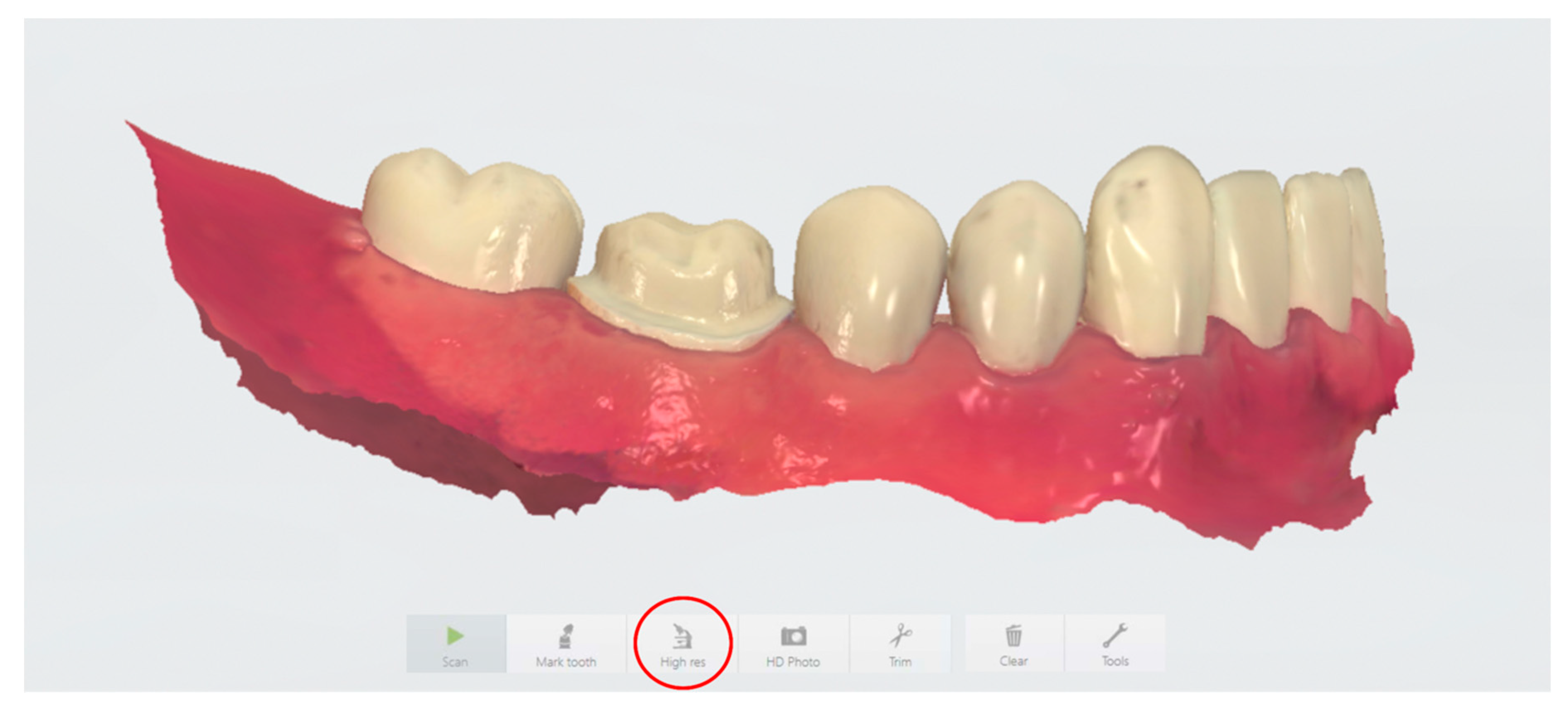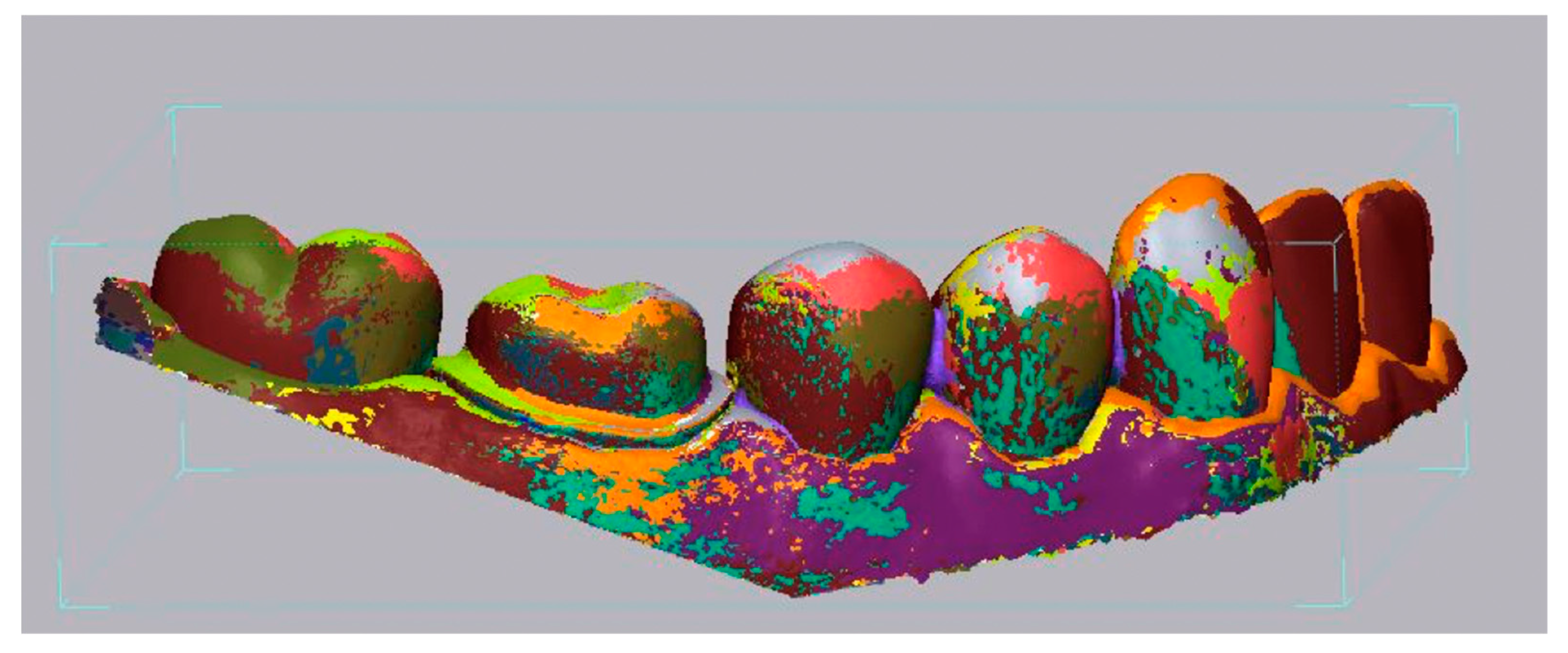Accuracy of CAD/CAM Digital Impressions with Different Intraoral Scanner Parameters
Abstract
:1. Introduction
2. Materials and Methods
2.1. Control Scan Preparation
2.2. Digital Impression Scan Preparation
2.3. Statistical Analysis
3. Results
4. Discussion
5. Conclusions
- Significant differences in terms of scan time and number of images captured per scan were observed among the three groups with different scanning resolution settings.
- No significant difference was observed between default resolution and high resolution in terms of accuracy on the crown preparation cavosurface finish line using the 3Shape TRIOS 3 intraoral scanner.
- Scanning accuracy was significantly affected by tooth surface, with the distal surface demonstrating the lowest accuracy.
Author Contributions
Funding
Acknowledgments
Conflicts of Interest
References
- Miyazaki, T.; Hotta, Y.; Kunii, J.; Kuriyama, S.; Tamaki, Y. A review of dental CAD/CAM: Current status and future perspectives from 20 years of experience. Dent. Mater. J. 2009, 28, 44–56. [Google Scholar] [CrossRef] [PubMed] [Green Version]
- Persson, A.; Odén, A.; Andersson, M.; Englund, G.S. Digitization of simulated clinical dental impressions: Virtual three-dimensional analysis of exactness. Dent. Mater. 2009, 25, 929–936. [Google Scholar] [CrossRef] [PubMed]
- Moörmann, W.H.; Mörmann, W.H. The evolution of the CEREC system. J. Am. Dent. Assoc. 2006, 137, 7S–13S. [Google Scholar] [CrossRef] [PubMed]
- Renne, W.; Ludlow, M.; Fryml, J.; Schurch, Z.; Mennito, A.; Kessler, R.; Lauer, A. Evaluation of the accuracy of 7 digital scanners: An in vitro analysis based on 3-dimensional comparisons. J. Prosthet. Dent. 2017, 118, 36–42. [Google Scholar] [CrossRef] [PubMed]
- Nedelcu, R.; Olsson, P.; Nyström, I.; Ryden, J.; Thor, A. Accuracy and precision of 3 intraoral scanners and accuracy of conventional impressions: A novel in vivo analysis method. J. Dent. 2018, 69, 110–118. [Google Scholar] [CrossRef]
- Yuzbasioglu, E.; Kurt, H.; Turunc, R.; Bilir, H. Comparison of digital and conventional impression techniques: Evaluation of patients’ perception, treatment comfort, effectiveness and clinical outcomes. BMC Oral Health 2014, 14, 10. [Google Scholar] [CrossRef] [Green Version]
- Punj, A.; Bompolaki, D.; Garaicoa, J. Dental Impression Materials and Techniques. Dent. Clin. N. Am. 2017, 61, 779–796. [Google Scholar] [CrossRef]
- Turkistani, A.; Nakashima, S.; Shimada, Y.; Tagami, J.; Sadr, A. Microgaps and Demineralization Progress around Composite Restorations. J. Dent. Res. 2015, 94, 1070–1077. [Google Scholar] [CrossRef]
- Hack, G.D.; Patzelt, S.B.M. Evaluation of the Accuracy of Six Intraoral Scanning Devices: An in-vitro Investigation. ADA Prof. Prod. Rev. 2015, 10, 1–5. [Google Scholar]
- Zimmermann, M.; Ender, A.; Mehl, A. Local accuracy of actual intraoral scanning systems for single-tooth preparations in vitro. J. Am. Dent. Assoc. 2019, 151, 127–135. [Google Scholar] [CrossRef]
- Boeddinghaus, M.; Breloer, E.S.; Rehmann, P.; Wöstmann, B. Accuracy of single-tooth restorations based on intraoral digital and conventional impressions in patients. Clin. Oral Investig. 2015, 19, 2027–2034. [Google Scholar] [CrossRef] [PubMed]
- Ender, A.; Attin, R.; Mehl, A. In vivo precision of conventional and digital methods of obtaining complete-arch dental impressions. J. Prosthet. Dent. 2016, 115, 313–320. [Google Scholar] [CrossRef] [PubMed] [Green Version]
- Renne, W.; Wolf, B.; Kessler, R.; McPherson, K.; Mennito, A. Evaluation of the Marginal Fit of CAD/CAM Crowns Fabricated Using Two Different Chairside CAD/CAM Systems on Preparations of Varying Quality. J. Esthet. Restor. Dent. 2015, 27, 194–202. [Google Scholar] [CrossRef] [PubMed]
- Ahlholm, P.; Sipilä, K.; Vallittu, P.; Jakonen, M.; Kotiranta, U. Digital Versus Conventional Impressions in Fixed Prosthodontics: A Review. J. Prosthodont. 2016, 27, 35–41. [Google Scholar] [CrossRef] [PubMed] [Green Version]
- Att, W.; Komine, F.; Gerds, T.; Strub, J.R. Marginal adaptation of three different zirconium dioxide three-unit fixed dental prostheses. J. Prosthet. Dent. 2009, 101, 239–247. [Google Scholar] [CrossRef]
- Medina-Sotomayor, P.; Pascual, A.; Camps, I. Accuracy of four digital scanners according to scanning strategy in complete-arch impressions. PLoS ONE 2018, 13, e0202916. [Google Scholar] [CrossRef] [Green Version]
- Medina-Sotomayor, P.; Pascual-Moscardo, A.; A, I.C. Accuracy of 4 digital scanning systems on prepared teeth digitally isolated from a complete dental arch. J. Prosthet. Dent. 2019, 121, 811–820. [Google Scholar] [CrossRef]
- Albdour, E.A.; Shaheen, E.; Vranckx, M.; Mangano, F.; Politis, C.; Jacobs, R. A novel in vivo method to evaluate trueness of digital impressions. BMC Oral Health 2018, 18, 117. [Google Scholar] [CrossRef]
- Chun, J.-H.; Tahk, J.H.; Chun, Y.-S.; Park, J.-M.; Kim, M. Analysis on the Accuracy of Intraoral Scanners: The Effects of Mandibular Anterior Interdental Space. Appl. Sci. 2017, 7, 719. [Google Scholar] [CrossRef]
- Mangano, F.G.; Veronesi, G.; Hauschild, U.; Mijiritsky, E.; Mangano, F. Trueness and Precision of Four Intraoral Scanners in Oral Implantology: A Comparative in Vitro Study. PLoS ONE 2016, 11, e0163107. [Google Scholar] [CrossRef]
- Müller, P.; Ender, A.; Joda, T.; Katsoulis, J. Impact of digital intraoral scan strategies on the impression accuracy using the TRIOS Pod scanner. Quintessence Int. 2016, 47, 343–349. [Google Scholar] [CrossRef] [PubMed]
- Motel, C.; Kirchner, E.; Adler, W.; Wichmann, M.; Matta, R.E. Impact of Different Scan Bodies and Scan Strategies on the Accuracy of Digital Implant Impressions Assessed with an Intraoral Scanner: An In Vitro Study. J. Prosthodont. 2019. [Google Scholar] [CrossRef] [PubMed] [Green Version]





| Group | Scan Time (s) | Images Captured |
|---|---|---|
| SR | 75.05 ± 11.7 | 1124 ± 161 |
| SHR | 109.25 ± 12.6 | 1584 ± 179 |
| HR | 121.5 ± 25.5 | 1692 ± 358 |
| Group | Total Discrepancy (μm) |
|---|---|
| SR | 31.5 ± 5.5 |
| SHR | 33.2 ± 3.7 |
| HR | 33.6 ± 3.1 |
| Scan Resolution | Discrepancy by Surface (μm) | |||
|---|---|---|---|---|
| Buccal | Lingual | Mesial | Distal | |
| SR | 32.5 ± 4.2 | 21.6 ± 3.2 | 29.4 ± 4.5 | 56.1 ± 16.8 |
| SHR | 31.0 ± 4.9 | 17.9 ± 5.6 | 22.3 ± 3.8 | 68.2 ± 11.3 |
| HR | 26.1 ± 9.9 | 20.1 ± 7.0 | 26.2 ± 7.4 | 60.1 ± 15.5 |
© 2020 by the authors. Licensee MDPI, Basel, Switzerland. This article is an open access article distributed under the terms and conditions of the Creative Commons Attribution (CC BY) license (http://creativecommons.org/licenses/by/4.0/).
Share and Cite
Chiu, A.; Chen, Y.-W.; Hayashi, J.; Sadr, A. Accuracy of CAD/CAM Digital Impressions with Different Intraoral Scanner Parameters. Sensors 2020, 20, 1157. https://doi.org/10.3390/s20041157
Chiu A, Chen Y-W, Hayashi J, Sadr A. Accuracy of CAD/CAM Digital Impressions with Different Intraoral Scanner Parameters. Sensors. 2020; 20(4):1157. https://doi.org/10.3390/s20041157
Chicago/Turabian StyleChiu, Asher, Yen-Wei Chen, Juri Hayashi, and Alireza Sadr. 2020. "Accuracy of CAD/CAM Digital Impressions with Different Intraoral Scanner Parameters" Sensors 20, no. 4: 1157. https://doi.org/10.3390/s20041157
APA StyleChiu, A., Chen, Y.-W., Hayashi, J., & Sadr, A. (2020). Accuracy of CAD/CAM Digital Impressions with Different Intraoral Scanner Parameters. Sensors, 20(4), 1157. https://doi.org/10.3390/s20041157






